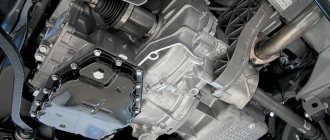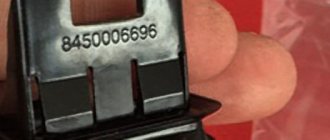Automatic and manual transmissions
Robotic gearbox
Automatic transmission
With the appearance on the market of a new product from AvtoVAZ, a lot of interest was born in this car. The vehicle has a dynamic appearance and decent tactical and technical characteristics. The Lada Vesta automatic is a significant alternative to versions with a manual transmission. Each model is characterized not only by the power of the internal combustion engine, the chassis, but also by the gearbox. A large number of consumers are worried about the choice: manual or automatic. Here, a lot depends on the needs of the owner and the equipment of the car itself.
AvtoVAZ has already used a robotic gearbox on previous versions of the Lada model range (Granta, Kalina). At that moment, AMT completely replaced automatics. The opinions of owners and professionals agree that this box has enormous advantages, and the French Renault even has plans to introduce a “robot” from Russian engineers to its models.
The price of a Lada Vesta with automatic transmission varies depending on the configuration. The cheapest option will be the Classic 1.6 AMT, which can be purchased for 595 thousand rubles. Luxe Multimedia 1.8 with automatic transmission is purchased for 740,000 rubles. The cost of a car with a manual transmission is lower than the price with an automatic transmission.
Manual transmissions
Until September 2021 The Lada Vesta was equipped with manual gearboxes manufactured by Renault, which, in order to optimize and reduce the cost, were replaced with Russian-made gearboxes. The new gearboxes, marked with the VAZ-21807 index, have become a reinforced version of the traditional base VAZ-2180 gearbox, equipped with a cable drive shift mechanism. Modification 21807 is designed for higher torque than 2180 and is much quieter than the original box.
With the change of box, the gear ratio of the main pair was slightly increased from 3.87 to 3.94. Vesta has also become more dynamic according to the passport: the acceleration time to 100 km/h has decreased from 11.2 s to 10.2 s and the maximum speed has increased from 175 km/h to 188 km/h. Although, as a minus, it can be noted that fuel consumption has increased slightly: from 6.9 to 7.5 l/100 km in the combined cycle.
Related Posts
Lada Granta FL standard radio and installation of the upgraded version
Which spark plugs are suitable for replacement in Lada X Ray?
Resign!
But I would say that the main news from the test is not the driving impressions. There will be no more Vesta with the robot! There are no such versions in the new price lists. That is, the client’s real choice between AMT and CVT is possible only if he is ready to consider the option on the secondary market. Well, or right now he runs out to the dealer in the hope of catching a car from stock.
Fog lights play the role of static lighting, turning on when you turn the steering wheel or turn on the turn signal. Due to the weak lamps, this feature is of little use.
Fog lights play the role of static lighting, turning on when you turn the steering wheel or turn on the turn signal. Due to the weak lamps, this feature is of little use.
The additional payment for the CVT regarding the mechanics is the same as for the Xray Cross - 50 thousand rubles (they asked for half as much for the robot). In my opinion, adequate. Yes, it has become more expensive, but in the eyes of Russians a CVT should be in every way better than a robot with a tarnished reputation. In addition, CVT is available in all trim levels, starting with the base one. The price range ranges from 736,900 rubles for a minimally equipped sedan to 982,900 for a SW Cross station wagon packed with all options.
Competitors are at least 80–100 thousand more expensive, so Vesta maintains the existing gap with foreign cars. With the help of the CVT, VAZ expects to increase the share of “two-pedal” cars in the sales structure from the current 9% to at least 30%. Quite realistic, because for Korean cars, automatic machines account for almost three-quarters of the demand! What I mean is that even among buyers of inexpensive cars, more and more people are willing to pay extra for comfort. And Lada Vesta began to offer it incomparably more than before.
The Exclusive package is now available not only for the sedan, but also for the SW station wagon. Its distinctive features on the outside are black mirror housings... |
...nameplates on the trunk lid and rear doors, muffler tip, spoiler (for a sedan) and... |
...16-inch two-tone wheels of original design. By the way, in other trim levels the style of the “sixteenth” alloy wheels has changed. |
Technical characteristics of Lada Vesta 1.6 CVT
| Length/width/height/base | 4410/1764/1497/2635 (4424/1785/1537/2635)* mm | |
| Trunk volume (VDA) | 480 l | |
| Engine | petrol, P4, 16 valves, 1598 cm³; 83 kW/113 hp at 5500 rpm; 152 Nm at 4000 rpm | |
| Acceleration time 0–100 km/h | 11.3 (12.2) s | |
| Maximum speed | 175 (170) km/h | |
| Fuel/fuel reserve | AI-92/55 l | |
| Fuel consumption: combined cycle | 7.1 (7.4) l/100 km | |
| Transmission | front-wheel drive; CVT | |
* Data in brackets for Lada Vesta SW Cross 1.6 CVT (if different)
Lada Vesta with a CVT: what is AVTOVAZ being disingenuous about?
Automatic boxes
The first automated gearbox, VAZ’s own AMT design, appeared in the fall of 2014. It is designed on the basis of a 5-speed manual gearbox and complemented by an electronic control unit and ZF actuators.
In February 2021 New AMT 2.0 robots also appeared, replacing the first AMT development. The AMT 2.0 robotic gearbox is installed only on 1.8 engines, however, it is possible to reflash cars of previous releases, including those with a 1.6 engine. To do this, you need to contact the dealership. To activate the Crawl mode on earlier cars, it is necessary to reflash the engine ECM and AMT. No structural changes are required to the car.
Automatic transmission problems for the Russian new car
Automatic transmission The idea of installing an automatic transmission is in the minds of Russian designers, but to bring it to life, special circumstances and high costs are needed. Management is already negotiating with foreign investors on the construction of a new enterprise, which will be equipped with everything necessary. Don’t forget: the Togliatti plant is focused on selling cars to the middle class of consumers.
- Today it is quite difficult to introduce expensive automation into the Lada Vesta.
- To create your own high-quality development, you need a base. In the case of automatic transmission, VAZ does not have one. The use of foreign parts increases the cost, which negatively affects sales themselves.
- The automated mode consumes much more fuel than its robotic counterpart. If we add here the cost of the second point, we get an incredibly expensive design. It is quite understandable that credit is given to AMT, which had a basic prototype for constructing its own box for the Lada Vesta.
On a note!
Information has appeared that they are launching a test drive to examine the operation of the automatic transmission (4 gears). VAZ directors rejected this news and said that if development begins, the automatic will be six-speed.
If you thoroughly understand which is better: a Lada Vesta automatic or a robot, it will take a lot of time. Both modifications have their own distinct pros and cons, visible to the naked eye.
Variable speed drive
And, of course, fans of the Togliatti auto industry are looking forward to the appearance of the promised CVT in 2021. According to preliminary information, a variator with an imitation of 7 steps will first be offered in combination with the Nissan 1.6L HR16 engine, since we are talking about the Jatco JF015E transmission, which is designed for torque up to 160 Nm. It is quite possible that in the future the CVT continuously variable transmission will be gradually adapted to its own 1.8L engine.
The advantages of a CVT over an AMT are obvious. This is, first of all, the convenience of speed control. Cars with CVT pick up speed especially smoothly, without jerks or dips. They have a smoother ride and more dynamic acceleration than AT cars. The CVT is significantly quieter and more economical than classic torque converter transmissions.
Nissan engine malfunctions:
At the moment it’s difficult to say anything about this engine in the VAZ version, because sales began relatively recently and the mileage of these engines is minimal. But the long history of the life of these engines on other cars can tell us something:
- Alternator belt whistling (tighten or replace belt)
- engine knocking during operation (most likely it’s time to adjust the valve clearance)
- hard to start in cold weather
The range of other motors installed on Vesta:
- VAZ 21179 1.8 l, 122 hp
- VAZ 21129 1.6l 106 hp
It is still unknown which transmission this engine will be paired with. In principle, both new mechanics and our robot will do.
What kind of automatic machine does the Lada Vesta have?
Automatic and manual transmissions The new product has two transmission options: domestic automatic and French manual.
Since many tests of the car were carried out (automatic test drive video below), we can confidently talk about the pros and cons of the first and second gearboxes. The difference between AMT (robot) and automatic transmission is quite significant. On the latter, switching occurs without driver participation. The first, in fact, is a mechanics modified by an electrical unit.
The global market has shown that the frequency of implementation of AMT in vehicles is beginning to fall, this is due to the following factors:
- the mechanism operates with small and unauthorized delays, which makes the driver very nervous;
- the robot switches gearbox gears quite sharply, this is noted by a large number of owners who have a colossal love for dynamic driving;
- The robot does not reduce gears in a timely manner on slopes, and when driving up a mountain in reverse, it excessively “rips” the gears.
Whose mechanics?
Perhaps one of the main questions among potential owners is the question related to the manual transmission, or rather, is there a French or Russian gearbox on the new Lada Vesta St. Cross station wagon of the 2021 model year? This question is very relevant, because... The first versions of the Vesta sedan were equipped with French transmissions, then in order to reduce the cost of the car, Vesta began to be equipped with Russian gearboxes. This raises a reasonable question: is Russian or foreign mechanics installed on the SV cross. We managed to find out from AvtoVAZ representatives that the car is equipped with a French 5-speed manual JR5 from Renault (the main pair is 4.212).
It is worth noting that the Lada Vesta sedan is equipped with two mechanical transmissions, the first made in Russia, the second made in France. You can understand which transmission a car is equipped with by looking at the engine index. The Russian box has the index VAZ-21179-01 (Vesta MT 21807), while the French one is called 21179-50 (Vesta MT JR5-515).
The disadvantages of the JR5 gearbox from Renault are the high price compared to the domestic design, there are problems with engaging reverse gear, and noisy operation (box whine).
Let's not get carried away
The CVT Vesta and the “mechanical” have the same mass - 1230 kg. An imported “aluminum” engine is lighter than a domestic “cast iron” one exactly as much as a CVT is heavier than a manual one. But 113 forces, partially eaten up by the variator, are clearly not enough for Vesta to vigorously overtake on the highway.
When there is a slow-moving vehicle ahead, there are no special problems. However, if you push the car at least from 90 km/h, the engine howls more than it drives. “Measure twice, overtake once” is the credo of the owner of a Vesta with a CVT.
Available configurations
If you go to the official website lada.ru, you will see that the most affordable configuration of the Vesta SV Cross, on which you can install a robotic box, is Luxe with the assigned code GFK32-52-X00. Its cost is 845,900 rubles. A machine of this configuration is equipped with almost everything necessary, is very comfortable and safe.
The next model configuration is called Luxe Multimedia with code GFK32-52-XK2. The price tag for it is higher than the previous one and equals 873,900 rubles. As is clear from the name of the configuration, the difference between it lies in multimedia. The more expensive trim level is equipped with a navigation system and six speakers, while the poorer trim level has “only” four speakers.
The last, most expensive trim level is Luxe Prestige. Code designation GFK32-52-XSH. It differs from the “multimedia” version in the presence of a rear armrest, tinted rear windows, a power outlet in the rear and heated rear seats. For the “fattest” configuration you have to pay 891,900 rubles.
To confirm our words about the cost of a robotic box, we offer you a few simple steps. Pay attention to the Luxe Multimedia package, but with a manual transmission.
Read also: Used car with automatic transmission
As you can see in the picture, the cost of a model with this equipment is 823,900, which is exactly 25,000 cheaper than with AMT. Simple math in action.
Operating rules
The driver is informed in the operating instructions about how the variator works on the Vesta. The control knob has the following switches:
- P – parking;
- R – back;
- N – neutral position;
- D – forward;
- M “+” and “–” – manual switching of a lower or higher gear.
Control knob on Vesta. Photo source: akppwiki.ru
The engine is started in position P. The brake pedal is pressed, and when the lock button is pressed, the handle is moved to D or R, depending on where the movement will be directed.
The gear shift lines are indicated on the handle:
- From P to neutral position N, forward – D, backward – R.
- In manual mode M, downshifts or upshifts are selected.
Mode M is activated only when moving from position D. You can move in reverse only by moving the handle to R from N. The engaged gear is displayed on the dashboard screen.
The rules prohibit moving the lever to the parking position P while driving. This action can lead to damage to the gearbox. When stopping briefly at a traffic light or in another similar situation, P and N are not activated and the vehicle is held down with the brake pedal.
To extend the service life of the transmission and avoid costly repairs, you should follow the rules prescribed in the instructions:
- before starting to drive, especially in winter, let the engine idle for a few minutes;
- immediately after starting to move, rapid acceleration is not recommended;
- the driver must avoid slipping, sudden starts and sudden braking;
- It is prohibited to tow the vehicle to start the engine.
Until the vehicle reaches a mileage of 2 thousand kilometers, towing other vehicles and trailers is prohibited.










